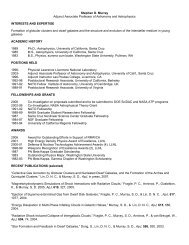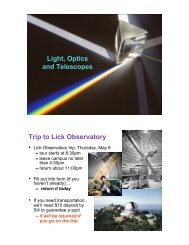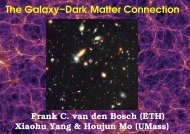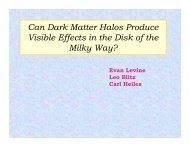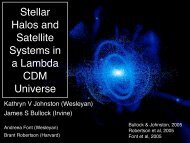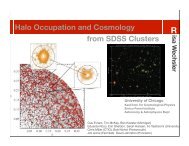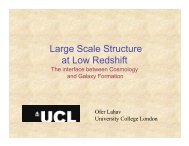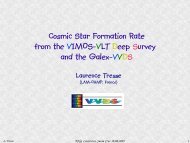UCSC Astronomy & Astrophysics Orientation Guide last update ...
UCSC Astronomy & Astrophysics Orientation Guide last update ...
UCSC Astronomy & Astrophysics Orientation Guide last update ...
You also want an ePaper? Increase the reach of your titles
YUMPU automatically turns print PDFs into web optimized ePapers that Google loves.
dynamos) and Francis Nimmo (who is an expert on impacts within the solar<br />
system and other aspects of planetary science).<br />
DEEP http://www.ucolick.org/~deep/<br />
The Deep Extragalactic Evolutionary Probe, composed of researchers at<br />
<strong>UCSC</strong> in collaboration with researchers at Berkeley, Caltech, U. of Chicago,<br />
Hawaii, and Johns Hopkins, is a long-term Keck and HST project. The broad<br />
goals of this large-scale survey of distant, faint field galaxies include studying<br />
galaxy formation and evolution, the origin of large-scale structure, the nature<br />
and role of dark matter, and the overall geometry of the universe. Phase I of<br />
DEEP, already complete, involved Keck observations with the then-current suite<br />
of instruments, and HST observations. The current phase of DEEP employs<br />
DEIMOS, a spectrograph for Keck just constructed at Santa Cruz, and SIRTF.<br />
Members of the DEEP team at Santa Cruz include Sandy Faber, Raja<br />
Guhathakurta, David Koo, and several postdocs.<br />
GLAST http://g<strong>last</strong>.gsfc.nasa.gov<br />
The Gamma-ray Large Area Space Telescope is a future NASA mission that<br />
should launch as early as 2007. It will study high-energy astrophysical<br />
phenomena, including but not limited to neutron stars and GRBs. Steve Thorsett<br />
is an interdisciplinary scientist on the GLAST team, and several faculty in the<br />
<strong>UCSC</strong> Physics Department are also involved.<br />
HETE http://space.mit.edu/HETE/<br />
The High Energy Transient Explorer mission launched, and the project is<br />
under way. HETE's goal is to provide precise localizations of gamma-ray bursts.<br />
This will facilitate follow-up observations of the afterglows, and further our<br />
understanding of GRBs a great deal. Stan Woosley and Steve Thorsett are<br />
affiliated with the project.<br />
HST http://www.stsci.edu/<br />
Of course, one of the premier instruments of astronomy today is the Hubble<br />
Space Telescope. Harland Epps was involved in the optical design of the<br />
NICMOS instrument; Sandy Faber was on the WFC team. Garth Illingworth is<br />
affiliated with the Advanced Camera. Many (if not most) researchers at <strong>UCSC</strong><br />
work with HST data regularly.<br />
NGST http://ngst.gsfc.nasa.gov/<br />
A high priority in major astronomy funding over the next decade, the proposed<br />
Next Generation Space Telescope will be an orbiting 6-meter class<br />
telescope. It is intended to pick up where HST leaves off. Garth Illingworth has<br />
some connection to the project.<br />
SCIPP http://scipp.ucsc.edu<br />
The Santa Cruz Institute for Particle Physics is primarily concerned with<br />
accelerator experiments at SLAC and CERN but is also involved in particle and<br />
13




